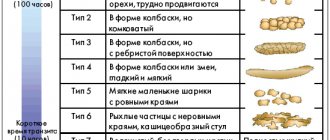- Treatment with folk remedies
If an adult’s cough does not go away, it is most often caused by improper treatment of the existing disease.
The most common causes include self-medication or lack of treatment for colds. Treatment of patients with diseases accompanied by coughing attacks is often carried out at home, only in severe cases it is carried out in a hospital.
A persistent cough is usually caused by untreated respiratory diseases.
Causes of a dry, persistent cough
A dry or unproductive reflex almost always accompanies pathological processes. Contrary to popular belief, a cough that does not go away for several weeks or a month or more is not always the result of problems with the lungs and bronchi. What diseases are we talking about?
Hyperthyroidism with goiter
Goiter is a nodular or more often diffuse enlargement of the thyroid gland, provoked by a number of exogenous and endogenous factors.
In this case, cough develops as a result of compression of the trachea and bronchi by an overgrown endocrine organ.
Excessive pressure leads to irritation of the lower respiratory tract.
The result is the formation of an intense reflex that will not go away until the operation is performed.
In this case, sputum production is not typical and is never observed. The release of exudate does not indicate the thyroid genesis of the disease.
Pleurisy
Inflammation of the outer lining of the lungs. The pleura is a thin membrane of the bronchopulmonary structures; it primarily performs a protective function.
Pleurisy almost never develops as a primary pathology.
Most often we are talking about a secondary process, which is explained by inflammation of the pulmonary structures, bronchi, tracheitis (during the descent of pathogenic flora into the lower respiratory tract).
The disease is accompanied by nonspecific symptoms, primarily an intense, painful cough without phlegm that can last for months, chest pain and others.
Rhinitis, sinusitis and other diseases of the upper respiratory tract
Paradoxically, it is possible to develop a cough even if the nasal passages and nasopharynx are affected. The reason is the flow of mucus and exudate, which is actively produced during a runny nose, into the lower respiratory tract.
Next, the mechanism goes through the standard path. The ciliated epithelium and its cilia perceive mucus and exudate as foreign objects that need to be expelled from the passages. A strong cough reflex develops.
In this case, there are practically no accompanying symptoms. This is a characteristic feature of the nasal nature of the cough.
Whooping cough
Childhood disease. It practically never occurs among adult patients, which is understandable.
This pathology develops with significantly reduced immunity, which is rarely observed in older patients.
The cough is intense, painful, clogging. It gets to the point where the patient begins to vomit from the force of the reflex.
Measles
Another inflammatory and infectious disease that occurs mainly in children and adolescents under 16 years of age. It is characterized by the same painful, long cough, although not always. Much depends on the strength of the infection.
Heart failure
Strangely, however, a cough can also develop as a result of congestive cardiac damage, which is explained by stretching of the ventricles of the heart.
It's all about disruption of gas exchange. When the heart muscle stops working as well as it should, the blood is less supplied with oxygen.
Shortness of breath begins, which leads to drying of the mucous membranes of the respiratory tract. The result is a cough, which is not always intense.
This is just one of the mechanisms for the formation of the reflex in heart failure. The disease is accompanied by many external symptoms. This dry cough does not go away for a month until the heart problems are eliminated.
Pharyngitis
It appears to be a disease in which inflammation of the pharyngeal mucous membranes and epithelial tissues occurs.
This unpleasant process is accompanied by sore throat, decreased swallowing activity of muscle structures, a dry cough, and voice disturbances (it becomes hoarse, hoarse, or disappears altogether).
Despite the discomfort of the current situation, pharyngitis extremely rarely produces complex and life-threatening symptoms. Although there is still a threat.
Most of the disease is infectious in nature; pathogenic flora can descend into the lower respiratory tract and develop secondary damage to bronchopulmonary structures.
Laryngitis
Despite the similarity of names, it has nothing to do with pharyngitis. Inflammation of the larynx forms. The cough with laryngitis is specific: it is barking, clogging, and booming in nature.
Timely treatment is required, since secondary respiratory failure and suffocation are quite possible. However, death occurs extremely rarely.
A dry, persistent cough thus develops for many reasons, but there are even more factors in the development of the wet reflex.
Wet cough
The productive reflex develops for several dozen reasons. If a cough with sputum does not go away for a month or more, we are talking about a number of diseases that are prone to a chronic, long-term course. Among all the most common diseases are the following:
- Influenza infection. Including acute respiratory diseases of a different nature. Surely everyone knows the following symptoms of a cold: wet cough with a lot of sputum, shortness of breath, breathing problems. These are manifestations of influenza infection or other acute respiratory disease. The flu itself, like other diseases, does not cause a cough. We are talking about secondary tracheitis; as a rule, secondary bronchitis is somewhat less common.
- Bronchitis. Inflammatory damage to bronchopulmonary structures. Accompanied by an intense cough with the discharge of a large amount of sputum (but not always), chest pain, and severe shortness of breath. Possible suffocation. Bronchitis, unlike pneumonia, is less aggressive and much less likely to lead to a fatal outcome of the disease. The pathology tends to become chronic, causing a residual cough that lasts for months.
- Pneumonia. Pneumonia is not always accompanied by a wet cough. It is possible for the disease to progress without any manifestation of a reflex from the lower respiratory tract. But most often there is a slight cough with a small amount of sputum. Similar to bronchitis, the pathology can take on sluggish forms that do not go away for years.
- Tracheitis. Defined as an inflammatory lesion of the tracheal mucosa. It is this structure that is most rich in nerves and ciliary epithelium, and therefore actively responds to inflammation and swelling. The cough is severe, with a lot of sputum, and lasts on average 2-3 weeks with appropriate treatment.
- Bronchial asthma. An obstructive disease, during which narrowing of the lumen of the bronchi and breathing problems occurs. The flow is paroxysmal, with the discharge of a small amount of mucous exudate. This cough does not go away for a long time in adults and children; the pathology can accompany the patient all his life.
- Tuberculosis and lung cancer. Both pathologies have the same symptoms. The leading manifestation is the discharge of bloody sputum.
- COPD (chronic obstructive pulmonary disease). Most often observed in patients with a significant history of smoking. It is characterized by destruction of the bronchial tree, constant obstruction, inability to breathe normally, and a wet cough. Potentially incurable disease.
- Reflux esophagitis with aspiration of gastric contents. Until the cause of the weakness of the gastric sphincter is eliminated (it happens that it cannot be cured), the cough reflex will haunt the patient.
- Bronchiectasis. Accompanied by the discharge of purulent exudate. The disease is typically characterized by the formation of purulent inclusions in the alveoli: the alveolar structures literally turn into sacs with exudate.
Folk remedies
An excellent way to cure a severe dry cough in adults at home, if there is no fever, is warming up in a Russian bath using medicinal herbs and coniferous plants.
It is useful to breathe infusions taken in equal proportions of plants (2 tablespoons each, boil in 2 liters of water for 10 minutes):
- chamomile, pine shoots, thyme, sage, eucalyptus shoots;
- birch leaves, spruce shoots, juniper, black currant, thyme, sage, lemon balm;
- St. John's wort, meadowsweet, mint, chamomile, sage, pine buds.
A bath for an adult who does not have heart disease provides a double healing effect - warming up combined with inhalation of moist warm air.
To soften sputum and improve its discharge, inhalations with soda, chamomile, and coltsfoot are used. Adults can use recipes that contain ingredients that increase blood circulation - pepper, ethyl alcohol.
- mix 2 tablespoons of honey and vodka;
- add egg yolk, mix;
- drink 1 teaspoon before meals three times a day.
An adult will benefit from a medicine containing milk containing onions and garlic. To prepare the product, you need:
- boil an onion with 1 head of garlic in 0.25 liters of milk;
- add 1 teaspoon each of honey and mint juice;
- drink 1 tablespoon every hour.
Coltsfoot, calendula and licorice have an antitussive effect. Honey is an effective remedy. It has a beneficial effect on the throat, enveloping it and reducing the symptoms. Honey can be used both independently and as part of a drink. To do this, the main ingredient is melted in a glass of warm milk. Honey along with grape juice speeds up the expectoration process.
Potato steam inhalations can not only eliminate a cough, but also a runny nose. To improve the effect, add a few drops of fir oil to boiled potatoes.
Steam inhalations based on mineral water have a beneficial effect on the human respiratory system. The effect is enhanced by lavender, mint and cedar oil. A decoction of chamomile and sage has a good effect.
Cough for more than a month
If the cough does not go away for a month or longer, it can develop as a result of the course of diseases of both described groups.
However, most often we are talking about pneumonia, bronchitis, and the asthmatic process.
These diseases always last a long time, are difficult to treat and tend to take a chronic form - which is why the cough does not go away for a long time.
However, if asthma occurs due to an allergic lesion, when the substance histamine is actively produced, it is enough to eliminate the allergen so that the problem becomes less urgent.
Associated symptoms
The cough almost never comes alone. Not counting some of the diseases described above.
In most cases, we have to talk about the following accompanying manifestations:
- Chest pain. They intensify when touching or trying to make a full breathing movement (usually while inhaling). Explained by the inflammatory process.
- Dyspnea. An increase in the number of respiratory movements at a certain point in time (per minute). It intensifies with physical activity, but persists at rest.
- Suffocation. Represents the inability to adequately perform respiratory movements. Often the result of suffocation is a violation of gas exchange. The result is respiratory failure. If normal treatment is not started, there is a high probability of death.
- Wheezing and whistling in the pulmonary structures when breathing.
Another characteristic symptom that occurs only with intense cough, tuberculosis and lung cancer is hemoptysis.
The patient coughs up blood in the form of streaks, or mixed into the structure of the mucous exudate. In this case, the sputum looks foamy and has a pinkish tint.
Manifestations from the gastrointestinal tract are possible if the cause of the cough is hidden in reflux or gastritis.
Why does a cough persist for a long time in an adult?
A persistent cough is a dangerous symptom that indicates a serious illness. Common causes: gastroesophageal reflux disease, bronchial asthma, heart failure, respiratory problems, colds, viruses.
A prolonged cough is usually accompanied by other symptoms: severe shortness of breath, chest pain, lethargy, colored sputum (yellowish, greenish, etc.), whistling and loss of voice.
If the urge to cough does not go away for a long time, you need to consult a doctor who will prescribe medication and draw up a therapeutic course.
After pneumonia
Residual cough after pneumonia, gradually fading, can persist for up to 1 month, which should not cause concern. A person who has had pneumonia continues to cough due to the slow recovery of lung tissue. In approximately 30% of those who have suffered the disease, the functional tissue is not restored at all: the affected areas become sclerotic, decrease in size, shrink, their blood supply is disrupted, and foci appear that predispose to the development of an infectious process.
If the cough does not go away after, the doctor draws up the last stage of the therapeutic course: prescribes medications that help eliminate the urge.
In adults, the urge to cough after pneumonia lasts longer than in children. In such cases, drugs of peripheral and central action are prescribed that suppress cough reflexes. Along with this, the specialist prescribes training exercises for the lungs, percussion massage, and inhalations.
Diagnostic methods
Diagnostic measures are quite complex; it is impossible to make a diagnosis on your own. Moreover, self-diagnosis is unacceptable. It is necessary to consult a doctor to start therapy in a timely manner.
A specialist should diagnose and treat cough with sputum and dry reflex.
The specialized doctor is a pulmonologist, however, due to the impossibility of contacting a specialist, an initial consultation with a therapist is recommended.
The most difficult treatment is a wet cough. That is why timely diagnosis is required so as not to waste valuable time.
At the initial appointment, a general assessment of the patient’s condition, an oral interview and anamnesis are performed.
Then comes the turn of specialized research:
- X-rays of the chest organs.
- Bronchoscopy.
- Analysis of sputum and examination of bacteriological profile material.
- FGDS.
- Blood tests.
- Listening to bronchopulmonary sound.
- Physical examination.
In general, diagnosis presents certain difficulties. It is especially difficult to differentiate between different diagnoses.
General principles of treatment
What to do if the cough does not go away? — General principles of therapy require the use of specialized drugs.
- If there are no functional problems, it is necessary to suppress the cough on its own. For this purpose, special pharmaceutical agents are prescribed to suppress the reflex at the central and peripheral levels. Accordingly, special brain centers and ciliary epithelium are inhibited. If adults’ cough does not go away, most often they take drugs from these particular groups on their own, which is wrong. We need to understand the situation.
- Allergies are treated with bronchodilators and antihistamines. These are Berodual, Salbutamol, and other medicines.
- Inflammatory and infectious diseases, including tuberculosis, are subject to curation using antibiotics, primarily fluoroquinolones.
- In all complex cases when respiratory failure occurs, the use of Prednisolone and other corticosteroids is required.
How does a cough appear?
A cough occurs when the cough receptors are irritated. They concentrate in certain areas of the mucous membrane of the respiratory system, forming so-called cough zones. It is irritation of these areas that most often causes coughing. These zones are:
- pleura,
- segmental and orifices of the lobar bronchi,
- tracheal bifurcation,
- larynx - subglottic space and vocal cords, anterior interarytenoid surface,
- posterior surface of the epiglottis.
In addition, a cough can occur when sensitive nerve endings located in other parts of the body are irritated, for example:
- oral cavity,
- other parts of the larynx,
- throat,
- paranasal sinuses,
- external auditory canal,
- eustachian tube,
- pericardium,
- distal part of the esophagus,
- stomach,
- diaphragm.
In this case, information from the cough zones or other cough receptors through the sensitive fibers of the branches of the vagus, superior laryngeal, glossopharyngeal or trigeminal nerves enters the “cough center” of the medulla oblongata, from where a response signal is sent to the muscles of the diaphragm, chest and abdominals, causing them to contract .
Typically, cough receptors in the respiratory system are represented by C-fibers and irritant receptors. C-fibers react predominantly to inflammatory mediators (bradykinin, prostaglandins, substance P, etc.), and irritant receptors cause coughing, becoming irritated upon contact with chemical, thermal or mechanical irritants.
Review of cough medicines
All drugs known today are divided into three groups in terms of their action:
| Expectorants | the action of these drugs is aimed at facilitating expectoration of sputum. Thanks to this, the cough quickly turns into a wet cough. Examples of such remedies are: Solutan, Mucoltin, Bronholitin, Marshmallow Root, Licorice Root and many others. |
| Mucolytic drugs | are intended to liquefy mucus that accumulates deep in the bronchi. Examples of the most effective drugs in this group are: Ambroxol, Bromhexine, ACC, Mesna and other drugs. |
| Antitussives | The main goal of drugs in this group is to influence the cough center in the nervous system and eliminate all symptoms. Examples of such medications are: Libexin (also good for bronchitis) and Tusuprex. |
| Combination medications | have expectorant and mucolytic effects at the same time. Examples of such drugs are: Doctor MOM, Codelac phyto and others. |
If all of the above medications fail, and the cough becomes prolonged and debilitating, then the doctor may prescribe Ethylmorphine, Oxeladin, Codeine, Butamirate and other similar prescription medications. [adsen]
Causes of prolonged cough
The most common causes of a persistent cough are:
- mycoplasma infection,
- whooping cough,
- a previous respiratory infection due to increased reactivity of the bronchial walls.
Chronic cough is characteristic of diseases such as:
- asthma (classic, cough form),
- gastroesophageal reflux disease,
- chronic sinusitis,
- in children - adenoiditis (inflammation of the adenoids),
- chronic nasopharyngitis.
Prolonged wet cough
If a prolonged cough is accompanied by sputum production, then you should think about malformations of the bronchopulmonary system, cystic fibrosis, bronchiectasis, primary ciliary dyskinesia syndrome, a foreign body not identified in a timely manner, chronic bronchitis (including smokers).
Prolonged dry cough
A prolonged dry cough is typical for:
- bronchial asthma, especially its cough form,
- interstitial lung diseases (for example, fibrosing alveolitis, sarcoidosis, pneumoconiosis),
- dysphagia or periodic aspiration of food if the child has a tracheoesophageal fistula - cough appears while eating or drinking,
- gastrophageal reflux disease - may manifest as a dry cough during sleep,
- tuberculosis - cough occurs mainly due to compression of the bronchial tubes, trachea by enlarged lymph nodes or the appearance of granulomas on the bronchial mucosa.
A dry, prolonged cough can occur with passive smoking, systematic inhalation of dust or smoke particles, otitis (Arnold's cough reflex in the presence of an additional auricular branch of the nerve), interstitial lung diseases, and pleurisy. In addition, prolonged cough is observed with mediastinal tumors, laryngeal papillomatosis, aortic aneurysm, and heart failure. In adults, one of the common causes of dry chronic cough is taking ACE inhibitors prescribed by a cardiologist, and in some children such a cough occurs when regularly stopping attacks of bronchial asthma with powdered anti-asthmatic drugs.
A cough that lasts more than 1 month also occurs with lung cancer and brain tumors if the cough center of the medulla oblongata is irritated.
Types of cough
If you listen to a cough, you can hear its different shades and varieties. There are several types:
- Whooping cough is characterized by multiple coughing shocks, which are accompanied by a deep breath with a whistling sound.
- If it is not too intrusive, with short coughs, then it is called pharyngeal. In this case, the mucous membrane of the pharynx dries out or mucus accumulates at the entrance to the larynx.
- When you hear low tones with a gradual increase, this may be a symptom of tuberculosis.
- A barking cough appears with laryngitis and tracheitis. It occurs due to inflammation of the vocal cords. If a barking dry cough is accompanied by difficult, bubbling breathing, then these are manifestations of croup.
- A spasmodic cough indicates bronchial asthma. He is unproductive and intrusive. He appears closer to morning. This condition may indicate obstructive bronchitis, but without a series of attacks.
- During a cold, an obsessive whooping cough may appear.
- A metallic tint of a dry cough that appears during conversation or while eating may indicate a mental disorder, but this is diagnosed only after a serious examination.
How is diagnosis carried out?
Due to the variety of causes of prolonged cough, the doctor begins a diagnostic study with a standard examination of the patient and a conversation with him. As a rule, the doctor will try to find answers to the following questions:
- cough duration,
- presence of sputum, its quantity, color, whether there is an admixture of blood,
- connection between cough and sore throat,
- the presence of other symptoms accompanying the cough,
- In addition to the cough, are there chest pains, fever, chills, sweating,
- whether there are attacks of wheezing, suffocation,
- whether the cough is accompanied by watery eyes, runny nose, or significant weight loss.
What to do if the cough does not go away for more than a month?
If the cough has been observed for more than a month, then it is necessary to see a doctor in order to identify its cause. After an appropriate examination and in-depth examination of the patient, the doctor will prescribe appropriate treatment depending on the identified cause.
Lifestyle
In any case, the following help significantly improve your well-being:
- quitting smoking, including passive smoking,
- ensuring the necessary air humidity,
- taking enough fluids daily,
- withdrawal of ACE inhibitors,
- breathing exercises.
Fighting cough
In addition to treating the underlying disease, the symptom of which is cough, after consulting a doctor, you can use the following medications:
1. Boring dry cough:
- narcotic antitussives, for example with codeine,
- non-narcotic antitussives (prenoxdiazine, dextromethorphan, adrenergic agonists, antihistamines),
- inhalation.
2. Wet cough:
- expectorants,
- mucolytics,
- physiotherapy.
Treatment of diseases accompanied by cough
- Bronchial asthma, obstructive bronchitis - inhaled or standard hormonal therapy, antihistamines.
- Tuberculosis - long-term use of anti-tuberculosis drugs.
- Taking ACE inhibitors in connection with diseases of the cardiovascular system - replacing ACE inhibitors with angiotensin type II receptor antagonists.
- Purulent lung diseases - antibiotic therapy (amoxicillin, second generation cephalosporins, etc.).
- Bronchiectasis - antibiotic therapy, postural drainage.
- Lung cancer - surgical treatment, radiotherapy and chemotherapy.
- Cystic fibrosis - dilution of viscous bronchial secretions (ambroxol, acetylcysteine, pulmozyme), expansion of the bronchial lumen (salbutamol, ventolin), fight against infection (broad-spectrum antibiotics, taking into account the sensitivity of the microflora).
How to treat dry cough
To alleviate the condition and soften the cough, the following methods are used:
- air humidification and maintaining optimal temperature (20 – 22 degrees);
- physiotherapy: inhalations with expectorant herbs, soda, UHF, electrophoresis, acupuncture, massage;
- taking cough drops.
Physiotherapy helps relieve inflammation and reduce dryness of the mucous membranes, and relieve swelling. In addition, in case of an infectious disease accompanied by symptoms of intoxication, you should drink more fluid.
What medications are used to treat a dry, exhausting cough?
In order to overcome a dry cough in an adult, treatment must be started immediately. Antitussive medications help alleviate the condition, as well as drugs that soften cough by improving sputum production. They are available in the form of tablets and syrups.
Antitussive drugs for adults with central action: Codeine, Ethylmorphine. These drugs are classified as narcotic drugs and should be used with caution as prescribed by a doctor. Non-narcotic antitussives include Ambrobene, Glaucine, Butamirate, Omnitus, Prenoxdiazine (Libexin), Sinekod.
Expectorants
To soften the cough, the following groups of drugs for dry cough are used.
Drugs used to thin and soften sputum. ACC-Long and Flavamed help a lot. Bromhexine, Lazolvan and Mucaltin remain effective remedies to help get rid of dry cough.
Combination drugs
Combined drugs include Bronholitin (antitussive, bronchodilator, antiseptic effect).
In case of asthma attacks, it is appropriate to use the corticosteroid drug Pulmicort as prescribed by a doctor (mainly used for bronchial asthma).
Attention! These medications are not used for productive coughs to avoid stagnation of sputum in the bronchi and the development of infection!
Combined remedies will help to safely relieve a coughing attack: Codelac, Eucabal. Don’t forget about herbal remedies that help effectively transform a dry cough into a productive one. These are licorice root syrup, Herbion, Gedelix, Prospan and others.
For allergic cough, antihistamines will be effective: Loratadine, Agistam, Suprastin. If the disease is viral or bacterial in nature, antiviral drugs and antibiotics should be taken accordingly. The most popular is Ceftriaxone: it gives a good effect and is effective in nonspecific inflammatory processes of the respiratory tract.
It is also appropriate to take anti-inflammatory drugs in the complex treatment of the disease: Diclofenac, Voltaren.
Important! In case of illness, do not select treatment on your own, seek medical help from a specialist! Treatment is selected comprehensively and individually for each patient. The drugs you choose can harm your health!
Prevention
Most diseases of the bronchopulmonary system respond well to treatment in the initial stage of the disease. For this reason, it is necessary to regularly undergo preventive examinations, including FGL, and, if necessary, spirography. In children, instead of fluorography, an annual Mantoux test is performed. To prevent the development of occupational diseases, the microclimate in premises and production workshops should be improved, and personal protective equipment should be used when working in dusty conditions.
In case of allergic diseases, you should limit contact with allergens: for example, wear a gauze bandage during ragweed blooming, change your diet in case of food allergies, etc.
Source











